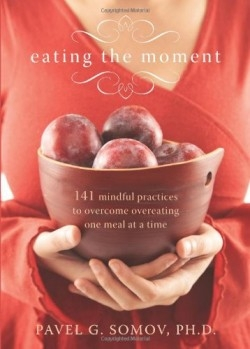
Eating the Moment
141 Mindful Practices to Overcome Overeating One Meal at a Time
The practice of mindfulness (full awareness of the present moment), is used to treat a multitude of health and psychological difficulties. Here, the author, a private psychologist who regularly evaluates people who are considering gastric bypass surgery, promotes mindful eating. With a doctorate in counseling psychology from the State University of New York at Buffalo, Somov has developed a mindful-eating program based on effective techniques for his clients. His 141 exercises apply not only to very overweight individuals, but also to anyone desiring to adopt a more conscious and healthy eating lifestyle.
The book is arranged flexibly, so as to be either read cover-to-cover or randomly. If readers choose to skip around, the exercises are labeled with ei-ther an AB (an awareness-building level) or an HM (a habit-modifying level) or both. The exercises are based on four reasons why people engage in over-eating: mindlessness of environmental triggers, of the eating process, of feeling full, or of eating for emotional reasons.
Full and present awareness is useful in controlling cravings. By merely noticing something without becoming attached to it, individuals can achieve “disidentification.” With food cravings specifically, mindfulness reveals that craving is a transient state of mind, not the mind itself. “Yes, it is a part of you, but it’s not all of you,” the author points out. No one should strive to block thoughts of food, instead they should recognize them as mere sensations. In short, the author maintains, “mindfulness is a form of controlling by letting go of control.”
Offbeat exercises are designed to break automatic behavior associated with food. The author asks readers to pack together pieces of a carrot cake and hurl the chunks at a tree. Although afterwards a carrot cake might scream “eat me,” it might also start to signal “throw me.” The author suggests that to broaden this exercise, readers should invent creative manners to interact with favorite foods “so that stuffing your face with it is no longer the only fun option at your disposal.”
As a final exercise, the author suggests developing a personal eating philosophy, including the purpose of eating and when to start and stop eating, but he does not dictate any specific terms, recognizing that individuals’ goals will differ. Much more than just a workbook for obese people, this collection of exercises will be useful for many who just want to lose ten pounds. (November)[/i]
Reviewed by
Beth Hemke Shapiro
Disclosure: This article is not an endorsement, but a review. The publisher of this book provided free copies of the book to have their book reviewed by a professional reviewer. No fee was paid by the publisher for this review. Foreword Reviews only recommends books that we love. Foreword Magazine, Inc. is disclosing this in accordance with the Federal Trade Commission’s 16 CFR, Part 255.
